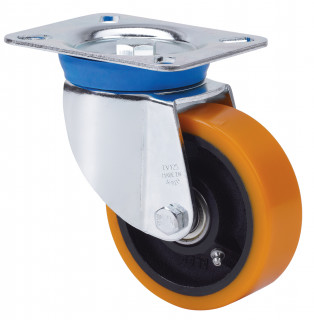In order to determine the number of castors or wheels you will require, several factors must be taken into account: unloaded weight, maximum load, number of castors or wheels and working conditions.
The working conditions, floor surfaces and conditions are very important elements that must be taken into consideration when calculating the load capacity. This is especially true of uneven and rough surfaces which can easily overload three of the tour castors.
With this in mind, a definition of standard conditions would be a surface on which castors are not overloaded, receive no impacts and which is smooth, non-abrasive and free of obstacles, cracks, grooves, doorjambs, nails, etc.

In order to guarantee the quality of our industrial castors and the adjustment to each necessity, Alex castors and wheels uses the load capacity formula:

- C: Required load capacity of the castor or wheel
- P: Dead Weight of the transit unit
- M: Maximum additional Load
- N: Number of castors or wheels
- S: Safety factor
The safety factor is used when conditions vary from standard. This varies from 1•3 to 2 depending on the actual conditions encountered.
All load capacities in this catalog have been calculated according to European Materials Handling Standards: EN 12528 and EN 12533.
The following symbols have been used in the catalogue and search engine so as to make interpretation of technical specifications easier and quicker:



















2 swivel castors and 2 fixed castors
Industrial applications. They are easily manoeuvrable for medium loads over long distances. Maximum Load Capacity = Total Load/3

4 fixed castors central pivoting
For medium- heavy loads. Good straight travelling and relatively easy manoeuvrability. The two central fixed castors are used to pivot on when manoeuvring. Castors can be replaced by wheels on a central axle. Maximum Load Capacity = Total Load/2.

2 swivel castors and 2 fixed castors in the centre
Good load capacity and manoeuvrability in small spaces. Fixed castors can be replaced by a one wheel set. Maximum Load Capacity = Total Load/2

4 swivel castors
Good load capacity and excellent manoeuvrability in all directions. Not for use over long distances or uneven surfaces. Maximum Load Capacity = Total Load/2

1 swivel castor and 2 fixed castors
For use with light loads for manoeuvrable trolleys. Weight should be evenly distributed on a small appliance. Maximum Load Capacity =Total Load/3.

4 swivel castors and 2 fixed castors in the centre
Ideal for large trolleys and heavy loads.Trolleys should have a strong base and will turn on the centre castors. Maximum Load Capacity = Total Load/2.

3 swivel castors
First-rate manoeuvrability. Recommended for drums and barrels and light trolleys. Maximum Load Capacity = Total Load/3.


